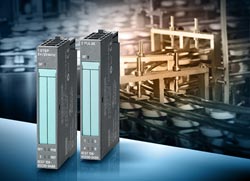Distributed positioning and controlling of stepper motors, actuators and valves

On the dual-channel technology module 2 PULSE that controls actuators and valves it is now possible to measure and precisely regulate the current that is output. A new traversing task for approaching a specified position has been integrated in the single-channel stepper motor module 1 STEP for positioning tasks in combination with stepper motors.
The dual-channel technology module 2 PULSE for controlling actuators and valves now also measures the current that is output in the PWM (pulse width modulation) and pulse train modes and sends the value back to the CPU. This enables simple proportional valves to also be directly connected and precisely controlled. This means a further improvement in the precision of control in isochronous mode. To improve performance the two channels of the module can be switched in parallel, thus providing a current of up to 4 amps. Further modes are frequency output, output of a pulse with a predefined length, and ON/OFF delay.
There is now a new “traversing task” for approaching a specified position on the single-channel stepper motor module 1 STEP. In speed mode the frequency specified by the controller is transmitted to the output taking the acceleration/deceleration ramp into account. This mode is suitable for use with a higher-level positioning control, also in isochronous mode if required. The 1 STEP module has two digital inputs that can be configured as a reference point switch, a limit switch, or as an external start enable.
The Siemens Industry Sector (Erlangen, Germany) is the worldwide leading supplier of environmentally friendly production, transportation, building and lighting technologies. With integrated automation technologies and comprehensive industry-specific solutions, Siemens increases the productivity, efficiency and flexibility of its customers in the fields of industry and infrastructure. The Sector consists of six divisions: Building Technologies, Drive Technologies, Industry Automation, Industry Solutions, Mobility and Osram. With around 207,000 employees worldwide (September 30), Siemens Industry achieved in fiscal year 2009 total sales of approximately €35 billion.
The Siemens Industry Automation Division (Nuremberg, Germany) is a worldwide leader in the fields of automation systems, industrial controls and industrial software. Its portfolio ranges from standard products for the manufacturing and process industries to solutions for whole industrial sectors that encompass the automation of entire automobile production facilities and chemical plants. As a leading software supplier, Industry Automation optimizes the entire value added chain of manufacturers – from product design and development to production, sales and a wide range of maintenance services. With around 39,000 employees worldwide (September 30), Siemens Industry Automation achieved sales of €7.0 billion in fiscal year 2009.
Reference Number: IIA2010032234e
Media Contact
All latest news from the category: Machine Engineering
Machine engineering is one of Germany’s key industries. The importance of this segment has led to the creation of new university degree programs in fields such as production and logistics, process engineering, vehicle/automotive engineering, production engineering and aerospace engineering among others.
innovations-report offers informative reports and articles covering technologies such as automation, motion, power train, energy, conveyor, plastics, lightweight construction, logistics/warehousing, measurement systems, machine tools and control engineering.
Newest articles

Retinoblastoma: Eye-Catching Investigation into Retinal Tumor Cells
A research team from the Medical Faculty of the University of Duisburg-Essen and the University Hospital Essen has developed a new cell culture model that can be used to better…

A Job Well Done: How Hiroshima’s Groundwater Strategy Helped Manage Floods
Groundwater and multilevel cooperation in recovery efforts mitigated water crisis after flooding. Converting Disasters into Opportunities Society is often vulnerable to disasters, but how humans manage during and after can…

Shaping the Future: DNA Nanorobots That Can Modify Synthetic Cells
Scientists at the University of Stuttgart have succeeded in controlling the structure and function of biological membranes with the help of “DNA origami”. The system they developed may facilitate the…



